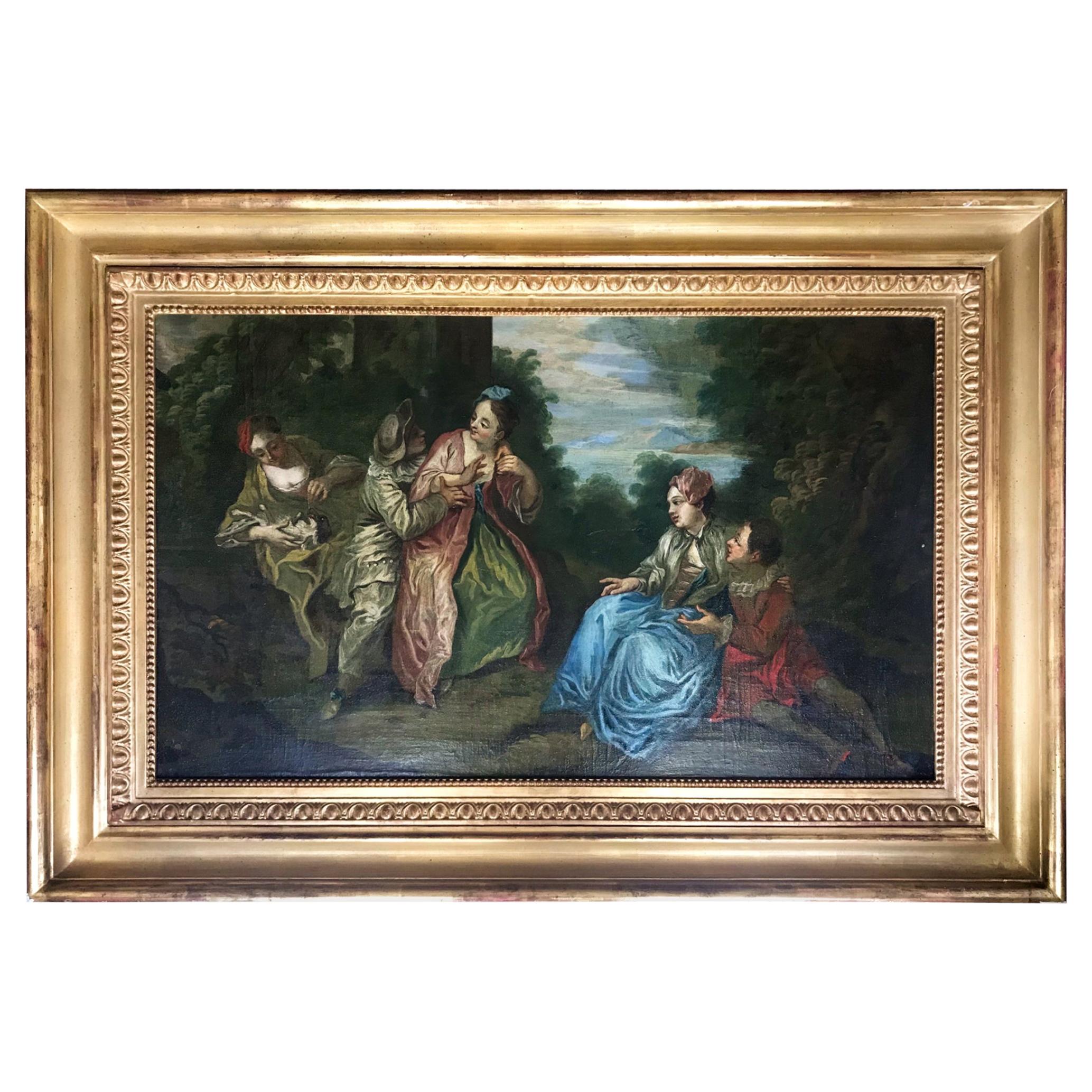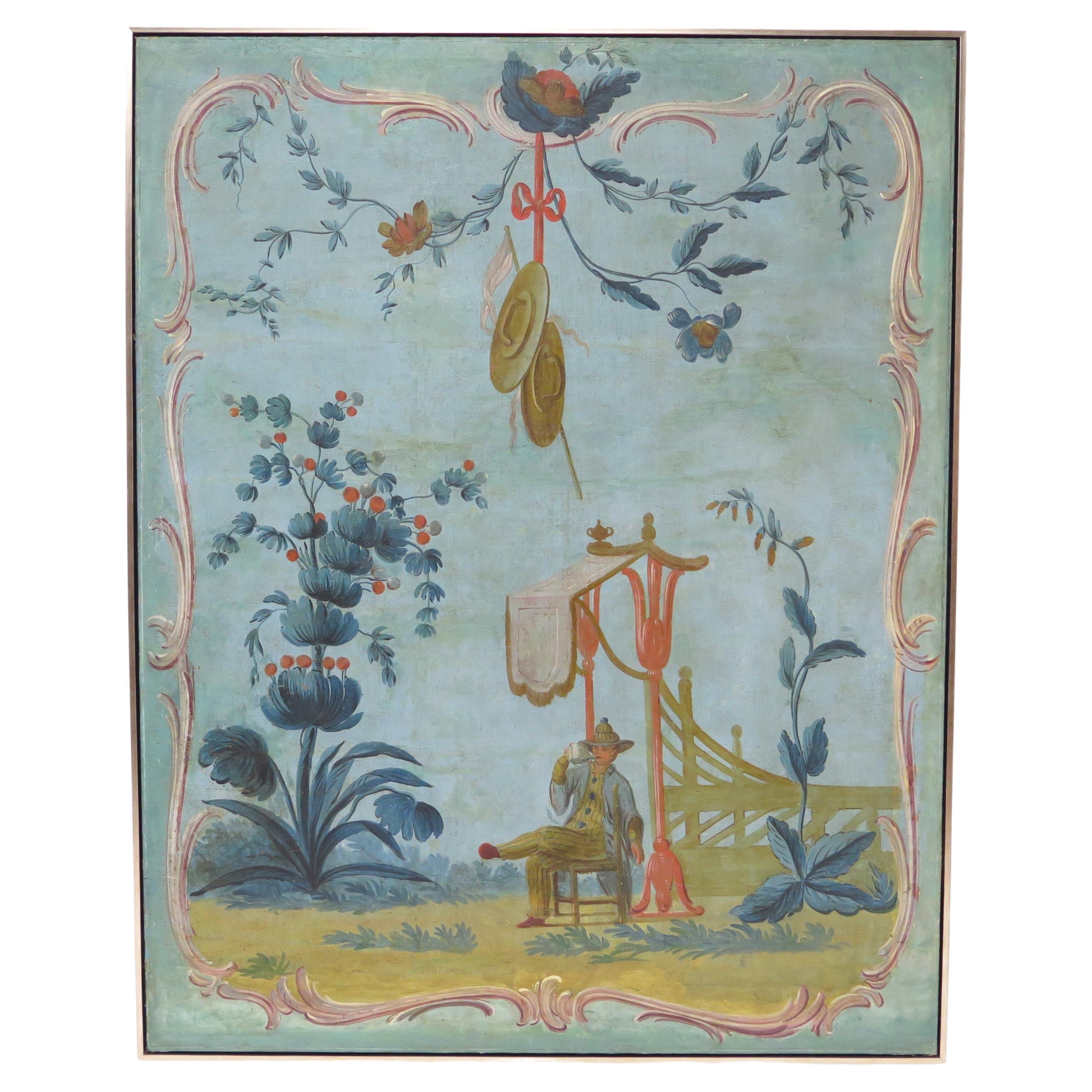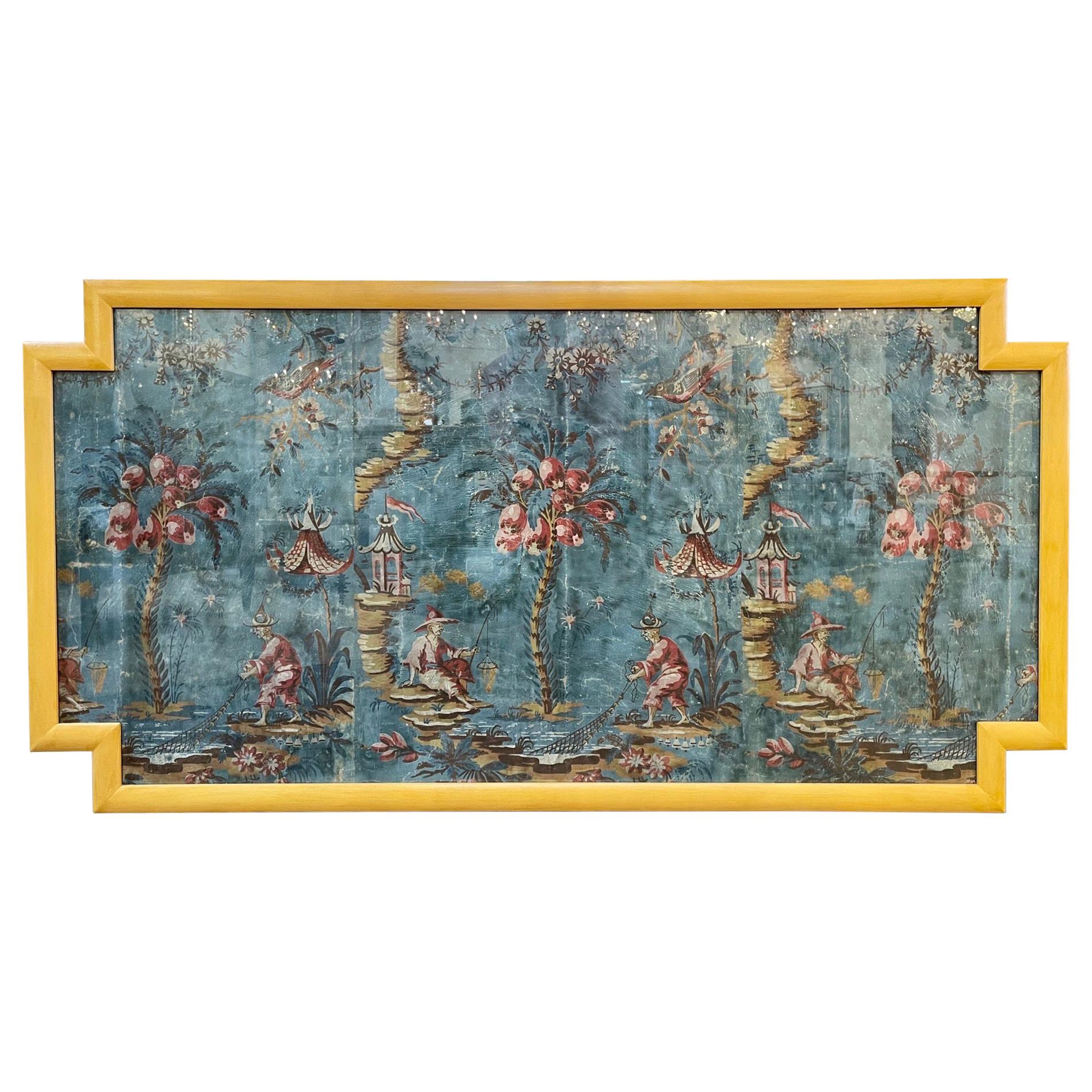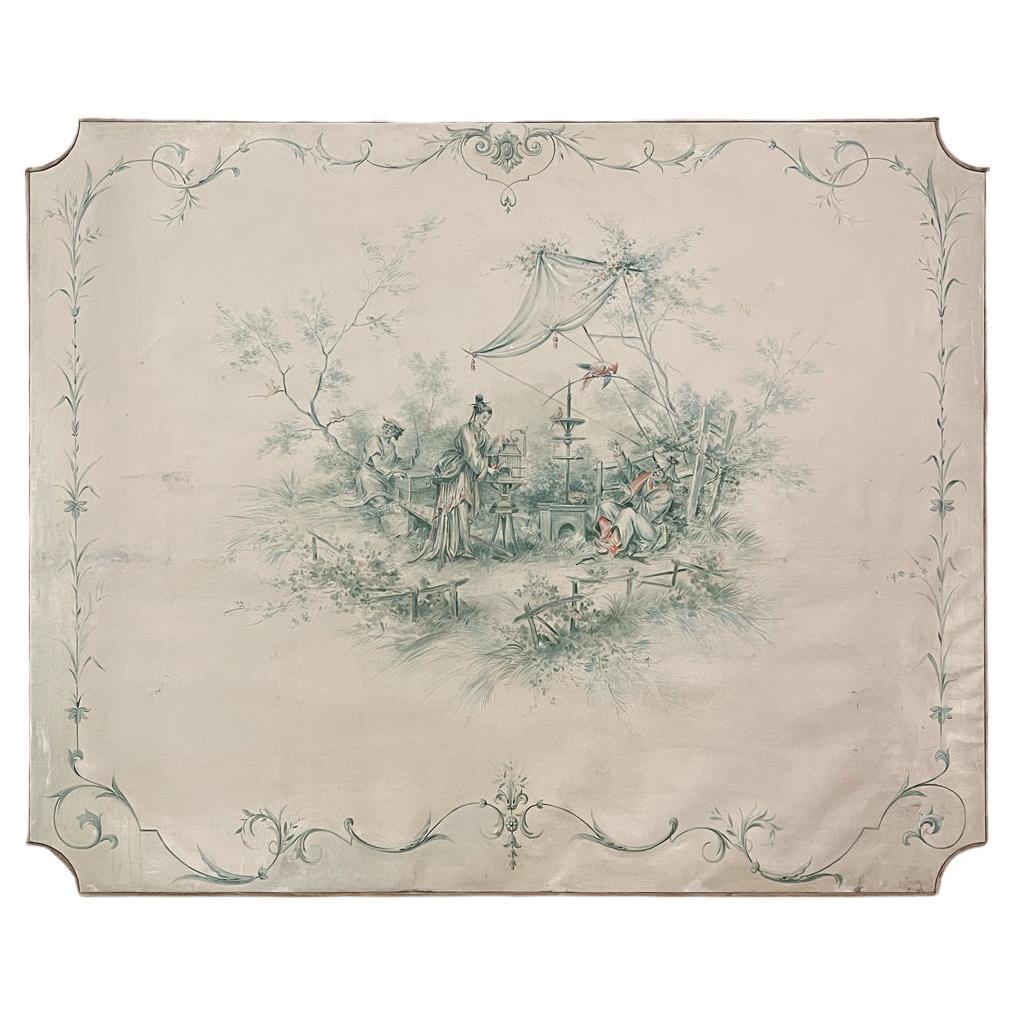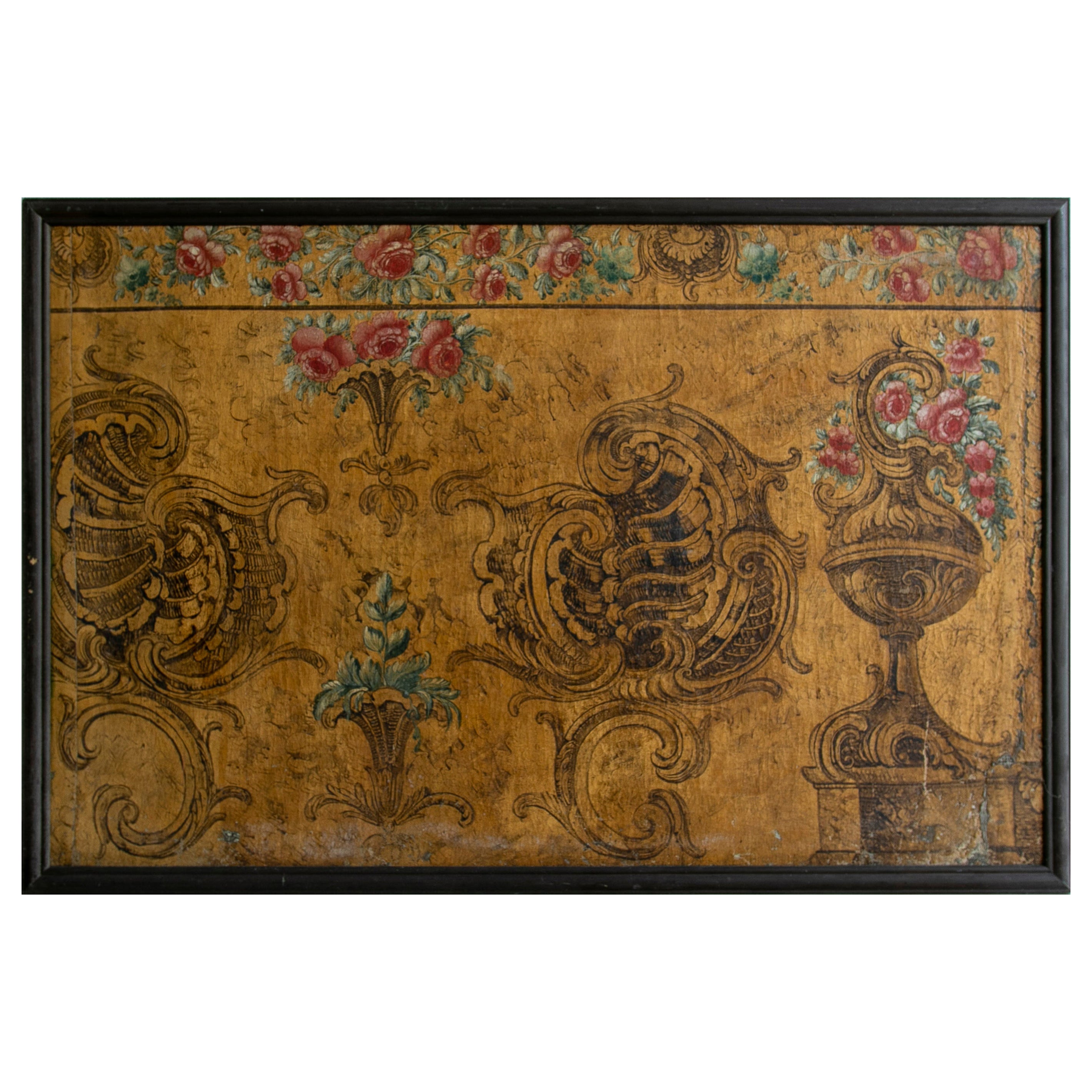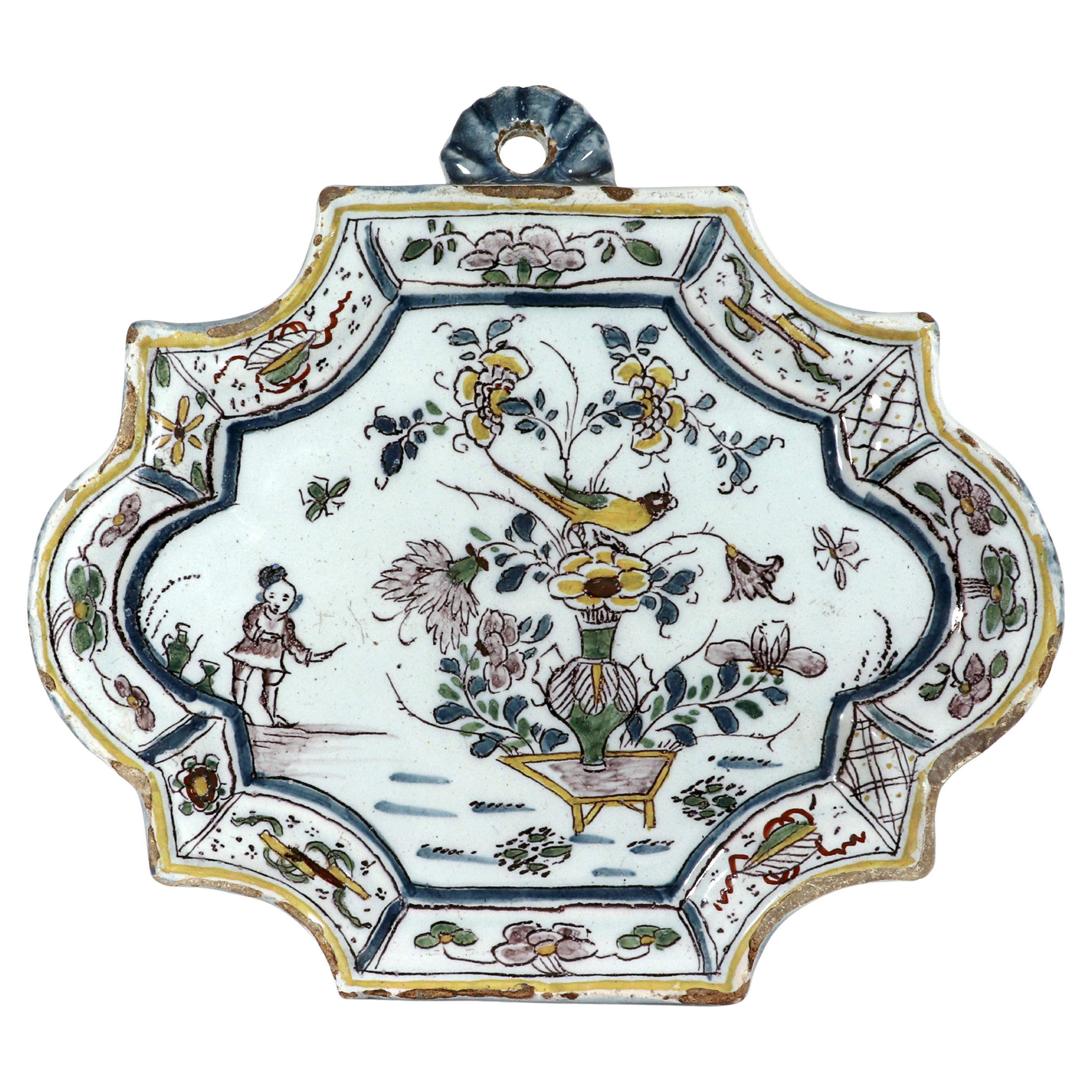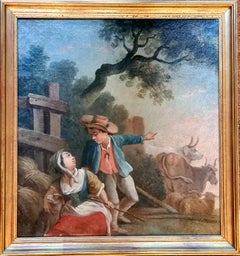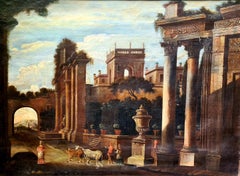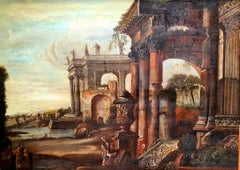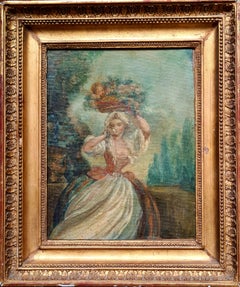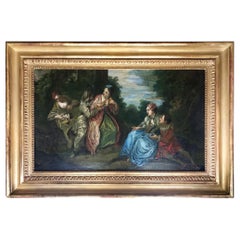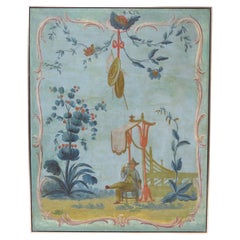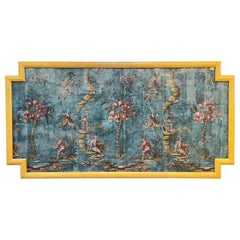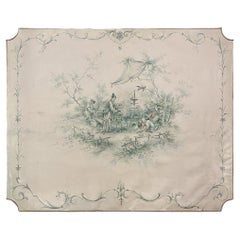Items Similar to 18th Century Rococo Chinoiserie Canvas, Camaïeu Bleu, Circle of Francois Boucher
Video Loading
Want more images or videos?
Request additional images or videos from the seller
1 of 12
18th Century Rococo Chinoiserie Canvas, Camaïeu Bleu, Circle of Francois Boucher1760s
1760s
$2,853.71
£2,140.50
€2,400
CA$3,983.76
A$4,314.89
CHF 2,285.36
MX$52,203.74
NOK 28,730.49
SEK� 26,782.93
DKK 18,282.78
About the Item
18th century oil on canvas chinoiserie scene painted 'en Camaïeu Bleu'. Originally part of a decorative scheme in a dining room as an overdoor set into panelling.
Provenance: From a Château in the South of France.
A very charming representation of a gentlemen sitting on a rocky outcrop playing a stringed instrument as birds and butterflies soar overhead, the whole is surrounded by a 'feigned' Rococo oval frame. It calls on all the fashionable influences of 18th century decorative schemes. The use of chinoiserie, rococo and rocaille elements and the interest in nature as well as the distinctive colour palette. It is clearly inspired by the works of Boucher and his circle who included all these elements in their compositions. This canvas would have been part of a much larger and important decorative scheme set into panelling or set above the doors in the corners of a room and therefore originally meant to have been viewed at an angle from below.
Camaïeu (also called en camaïeu) is a technique that employs two or three tints of a single colour, other than grey, to create a monochromatic image without regard to 'realistic' colour. When a picture is monochromatically rendered in grey, it is called grisaille; when in yellow, cirage
A major artist of the reign of Louis XV, François Boucher (1703-1770) is considered the emblematic painter of the rocaille style. His idyllic and voluptuous representations of classical and mythological themes, his allegories and his pastoral scenes particularly appealed to the Court and the King's favourite, Madame de Pompadour, who gave him many commissions, and who later became his pupil and friend from patron of the arts.
Many of the paintings of François Boucher, reveal another facet of the painter's talent and testify to the fascination exerted by China on the master. A lover of objects from the Far East, Boucher helped spread the fashion for "chinoiserie", the beginnings of Orientalism that tended to develop throughout Europe. The decorative arts of the eighteenth century were particularly marked by this thirst for exoticism, as evidenced by the appeal of porcelain imported from the East, the decoration of lacquered panels and the Chinese-style furniture of the English cabinetmaker Thomas Chippendale (1718-1779). These Chinese subjects were also made by Boucher "to be executed as tapestries at the Manufacture de Beauvais" as specified in the catalogue of the 1742 Salon where they were presented. The corresponding paintings are now kept at the Museum of Fine Arts in Besançon.
The history of these works originates from a commission from the Royal Manufacture of Beauvais, founded in 1664 by Colbert, who asked Boucher for models to create a new Chinese tapestry to follow the "History of the King of China" which included nine pieces, recounting the travels of the Emperor of China and the stay of Jesuit fathers astronomers at the court of Peking. executed around 1690 by Jean-Baptiste Monnoyer (1634-1699), Jean-Baptiste Belin de Fontenay (1653-1715) and Guy-Louis Vernansal (1648-1729).
The choice of Jean-Baptiste Oudry (1686-1755) and Nicolas Besnier (1686-1754), directors of the Manufacture de Beauvais, to entrust the design of the Chinese tapestry to François Boucher is not the result of chance. The Far East was a familiar theme for the artist, who himself had a large collection of Asian art objects composed of miniatures, paintings, lacquerware and porcelain, pieces probably acquired from his friend the dealer Edme-François Gersaint (1696-1750) manager of the shop "À la Pagode". Boucher had also already reproduced Chinese motifs after Watteau (1684-1721), in particular the Chinese-themed decorations of the Château de la Muette in the Recueil de Jean de Jullienne (1686-1766).
Boucher decided to approach Chinese life in its official aspects, such as in "The Audience of the Chinese Emperor" and in its popular aspects with, for example, "Chinese Dance" or "The Chinese Fair". To illustrate his subject, Boucher certainly used documentary sources such as travellers' chronicles or the writings and drawings of the Jesuits established at the court of Emperor Qiánlóng (1711-1799).
However, the artist seems to allow himself a certain freedom with regard to the Chinese reality, a certain number of anachronisms and inconsistencies are to be noted. Thus, in "The Audience of the Chinese Emperor", there are various elements that have nothing Chinese about them: a Polish-style bed, canopies supported by twisted columns similar to those of St. Peter's Basilica in Rome, an antique cassolette of Greco-Roman inspiration, characters wearing Persian turbans... moreover, this type of ceremony was subject to a stricter protocol than the scene depicted suggests.
More than real Chinese scenes, Boucher creates here a kind of oriental transposition of Western motifs and themes. He uses the same compositions, lines of force, framing and points of view, the same attitudes for his groups of characters... To give his compositions an appearance of local colour, he added elements known to the general public: pointed hats, porcelain objects, parasols, pagodas, etc. But Boucher's chinoiseries retain the codes of his universe. They prove his incredible ability to assimilate exotic motifs in order to recast them in the Rococo idiom, which led Edmond and Jules de Goncourt, in their book L'art du XVIIIe siècle, to say that Boucher had succeeded "in making China one of the provinces of the Rococo!"
- Creation Year:1760s
- Dimensions:Height: 19.69 in (50 cm)Diameter: 25.6 in (65 cm)
- Medium:
- Movement & Style:
- Circle Of:François Boucher (1703 - 1770, French)
- Period:
- Condition:There are extensive areas of wear to the canvas and paint losses over the whole surface. Once framed however it will present as a beautiful period piece in 'country house' condition.
- Gallery Location:Cotignac, FR
- Reference Number:Seller: LG/Chinoiserie1stDibs: LU1430215586812
About the Seller
5.0
Platinum Seller
Premium sellers with a 4.7+ rating and 24-hour response times
Established in 2000
1stDibs seller since 2020
286 sales on 1stDibs
Typical response time: 1 hour
- ShippingRetrieving quote...Shipping from: Cotignac, France
- Return Policy
More From This Seller
View AllRococo Pastoral Landscape, Figures, Oxen and Sheep Circle of Saverio Della Gatta
Located in Cotignac, FR
Late 18th or early 19th century oil on canvas Rococo idylic pastoral scene. Though not signed the painting is of very fine quality and is presented in a plain gilt wood frame.
This...
Category
18th Century Rococo Figurative Paintings
Materials
Canvas, Oil
Grand Tour 18th Century Veduta Capriccio Painting, After Gennaro Greco
Located in Cotignac, FR
A fine, large 18th century veduta capriccio scene with temple ruins after Gennaro Greco from the circle of Pietro Cappelli. The painting is presented in a more modern carved gilt woo...
Category
18th Century Baroque Landscape Paintings
Materials
Canvas, Oil
$9,036 Sale Price
20% Off
Large Grand Tour 18th Century Capriccio Painting Roman Ruins after Gennaro Greco
Located in Cotignac, FR
A fine, large 18th century veduta capriccio scene with temple ruins after Gennaro Greco from the circle of Pietro Cappelli. The painting is presented in a more modern carved gilt woo...
Category
18th Century Baroque Landscape Paintings
Materials
Canvas, Oil
$9,036 Sale Price
20% Off
Allegory of Love, Cupid With Beauty in Fine Dress Carrying a Basket of Flowers
Located in Cotignac, FR
A late 18th Century oil on canvas laid on board of a young beauty in period costume carrying a basket of flowers on her head. Presented in a very fine gilt, period 'Directoire' frame...
Category
Late 18th Century Romantic Figurative Paintings
Materials
Canvas, Oil, Board
The Harvest, Cherubs Disporting with a Goat, Fine Framed 18th Century Engraving
By Jean Jacques Lagrenée the Younger
Located in Cotignac, FR
Fine 18th century engraving by French artist Jean-Jacques Lagrenée. Presented with hand cut mount and gilt filet in fine wood and gilt 'ribbon and reed' frame.
Very charming renditi...
Category
Mid-18th Century Figurative Prints
Materials
Paper, Printer's Ink
18th Century Pastel Portrait of a Gentleman
Located in Cotignac, FR
Late 18th Century pastel portrait on paper of a bearded gentleman. Presented under glass in a fine period gilded carved wood frame.
A cha...
Category
Late 18th Century Rococo Portrait Drawings and Watercolors
Materials
Paper, Pastel
$837 Sale Price
20% Off
You May Also Like
18th Century French Rococo Painting Circle of François Boucher
By François Boucher
Located in Vero Beach, FL
18th century French Rococo Painting Circle of François Boucher
This idyllic pastoral oil painting shows Boucher’s impact on this f...
Category
Antique 18th Century French Rococo Paintings
Materials
Canvas
Louis XV-Period Painted Canvas Chinoiserie Panel Framed
Located in Dallas, TX
large-scale, grand Louis XV painted canvas panel once set in boiserie, very fashionable exotic Chinoiserie decoration, great colors, beautiful scene, a seated man relaxing in the sha...
Category
Antique Mid-18th Century French Louis XV Paintings and Screens
Materials
Canvas, Paint
18th Century Italian Chinoiserie Scene Painted Panel
Located in Dallas, TX
Lovely 18th century Italian painted panel featuring chinoiserie images. Vibrant colors of blue, pink, green and gold. Such an interesting piece ...
Category
Antique 18th Century Italian Chinoiserie Paintings
Materials
Wood
19th Century French Chinoiserie Hand-Painted Panel on Canvas
Located in Dallas, TX
19th century French Chinoiserie hand-painted panel on canvas was originally a decorative panel in a lavish home, resurrected and newly stretched and framed by our expert in-house sta...
Category
Antique Late 19th Century French Chinoiserie Paintings
Materials
Canvas, Paper
Mid 18th Century Italian Late Baroque / Rococo Oil on Cloth Framed Painting
Located in Marbella, ES
Antique mid 18th century Italian late Baroque / Rococo oil on cloth framed ornamental painting with rocaille, flowering roses and vases.
Category
Antique 18th Century Italian Paintings
Materials
Canvas
18th-century Dutch Delft Shaped Chinoiserie Polychrome Plaque
Located in Downingtown, PA
Dutch Delft Polychrome Chinoiserie Wall Plaque
Circa 1730-1740
This vibrant wall plaque is a superb example of Dutch Delftware, capturing the charm and technical skill of the Delft potters during the high period of the Rococo.
Description and Design
This beautifully modeled and painted plaque features an ornate, raised border composed of alternating cartouches, each filled with either floral sprays or Chinese auspicious objects.
The central scene is a charming and whimsical Chinoiserie fantasy. It depicts a gardener standing in a landscape next to a large vase of flowers, from which a large, colorful parrot perches on a branch. The composition is alive with details, including flying insects and the gardener's watering cans at his feet. The scene is painted in a distinctive and sophisticated palette of puce, yellow, and green, with blue accents. The plaque is surmounted by a molded blue shell, pierced with a hole for hanging.
Historical Background & Context 🧐
Dutch Delft and the China Trade: Delftware is the famous tin-glazed earthenware produced in the city of Delft from the 17th century onwards. Dutch potters, inspired by the beautiful and wildly expensive blue and white porcelain imported from China by the Dutch East India Company (VOC), developed this tin-glaze technique to create their own affordable versions.
The Move to Color: While Delft is famous for its blue and white wares, by the early 18th century (circa 1730-40), the potters began to introduce polychrome palettes to compete with the colorful Chinese famille verte and famille rose porcelain, as well as with rival European factories. This plaque, with its distinctive color scheme, is a perfect example of this fashionable shift.
Chinoiserie: This plaque is a wonderful expression of Chinoiserie, the imaginative and often fanciful European interpretation of Chinese life and art. The scene is not an accurate depiction of China but rather a charming pastiche of exotic elements—the gardener, the auspicious symbols—combined with familiar European motifs like the parrot, all designed to delight the eye and bring a touch of the exotic to a wealthy Dutch interior.
Condition, Provenance & Details
Condition: Excellent, original condition with no restoration. There is some minor, typical flaking to the glaze on the rim ("fritting"), which is characteristic of soft tin-glazed earthenware of this age.
Provenance: Formerly in the B.F. Edwards Collection...
Category
Antique 1730s Dutch Georgian Decorative Art
Materials
Delft, Faience
More Ways To Browse
18th Century French Rococo Painting
Used String Instruments
Madame De Pompadour
Qianlong Emperor
Polish Bed
Boucher Painting
Antique Overdoor
Bird Oil Painting 18th Century
Antique Canopy Beds
Antique Chinese Tapestry
Antique Chinoiserie Painting
Chinese Dancer
Antique String Instrument
King French Painted Frame Bed
Francois Boucher Tapestry
Chinoiserie Oil Painting
Jean Baptiste Monnoyer
English 18th Century Painting Allegory
